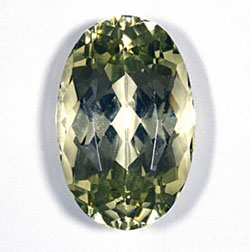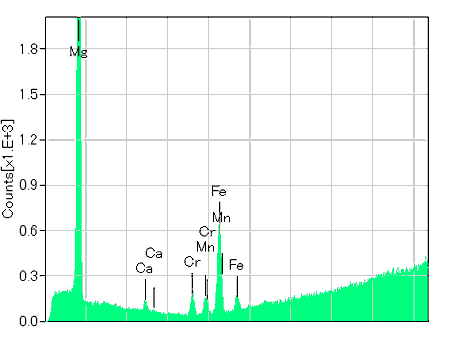|
|||||||
A yellow-green colour stone referred to as a gkyaniteh by a customer was brought into our laboratory for identification. After the research it was found to be a synthetic periclase, whose synthesis and its background are introduced here as well as the gemmological feature.
Periclase has a chemical formula of MgO and belongs to a cubic crystal system with a sodium chloride structure. The name came from the Greek word gperi + klassh which mean around + fracture, due to its perfect cleavage along the plane {001}. Natural periclase generally occurs in marble or contact zone as a metamorphic mineral of dolomite. It is very rare for this material to be cut for jewellery use, as most of rough stones are as small as less than one carat. On the other hand, synthetic periclase has been synthesised in larger size and some of them are cut and polished for jewellery use. Magnesia (MgO) = periclase has high melting point and it is highly resistant for ablation by basic slag or molten metals, and because of these features, periclase powder has been used as a fireproof brick for long period. A single crystal of periclase became in use as an optical material, a host material of solid-state laser or a substrate for ferroelectric thin film. Synthetic periclase for jewellery has a long history and its literature goes back as old as 1969, in which the material had been sold by the name gLaverniteh in the States at the time. In 1990fs, some reports of synthetic periclase appeared on the gemmological magazines overseas. One of these reports*) says that a facetable transparent crystal of periclase was obtained as a by-product of fireproof magnesia in Australia. In this process, a massive magnesite (MgCO3) from Kunwarara mine near Rockhampton in Queensland was fragmentised and heated, and then succeeding electron fusion produces ingot. This product has a diameter of two meters and has a centre made of fine polycrystalline material, around which is transparent crystal of gem quality with the width about ten centimetres. Shown in the photo-1 is the yellow-green transparent stone we introduce this month. It belongs to our customer who purchased it as a natural kyanite. The stone has RI 1.735 and SG 3.58, and it was inert under both LWUV and SWUV. No significant inclusions were seen under magnification. It showed anomalous double refraction due to strain similar to tabby extinction seen in a synthetic spinel under crossed polarised light. The X-ray fluorescence analysis showed over 99wt% of MgO, and minute amount of CaO, Cr2O3 and FeO were detected (Fig-1). The UV-visible spectral analysis showed a spectral pattern typically seen in many chromium-coloured gemstones.
*)@Reference: G. Brown. (1993) Australian Synthetic Periclase. Australian Gemmologist, November pp265-269 |
|||||||


